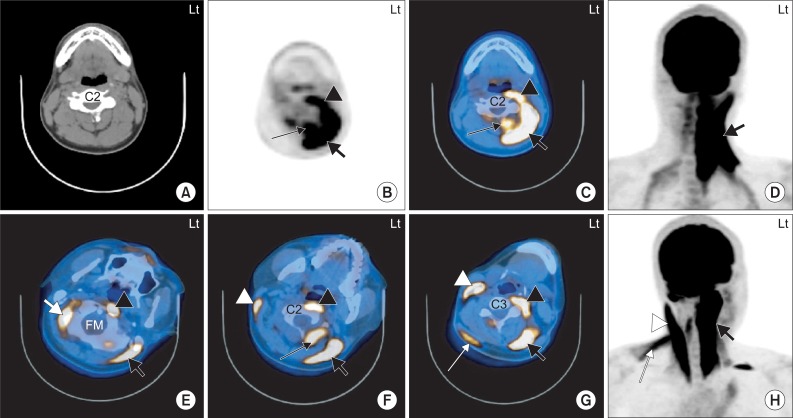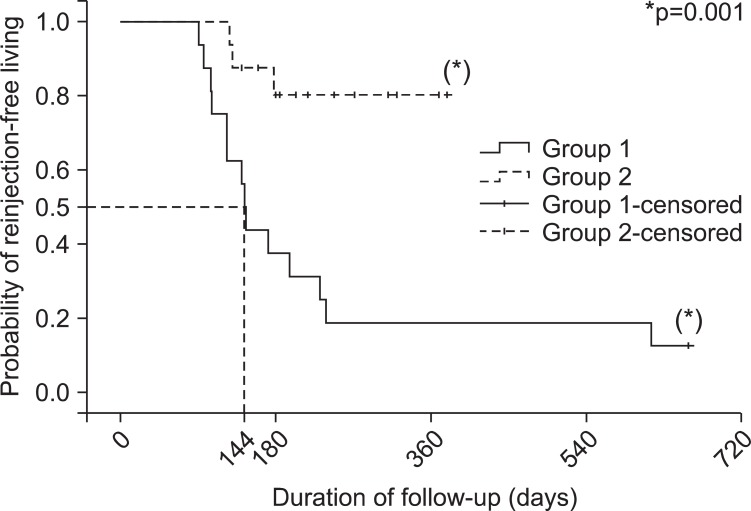Ann Rehabil Med.
2012 Dec;36(6):745-755.
Usefulness of 18F-Fluorodeoxyglucose Positron Emission Tomography/Computed Tomography in Management of Cervical Dystonia
- Affiliations
-
- 1The Center for Torticollis, Department of Physical Medicine and Rehabilitation, Ajou University School of Medicine, Suwon 443-749, Korea. syyim@ajou.ac.kr
- 2Department of Nuclear Medicine and Molecular Imaging, Ajou University School of Medicine, Suwon 443-749, Korea.
- 3Regional Clinical Trial Center, Ajou University School of Medicine, Suwon 443-749, Korea.
Abstract
OBJECTIVE
To evaluate the usefulness of 18F-fluorodeoxyglucose positron emission tomography/computed tomography (18F-FDG PET/CT) in the management of cervical dystonia (CD) with botulinum toxin type A (BoNT-A) injection. METHOD: Thirty two subjects with CD were included. A BoNT-A injection was provided either by clinically targeting method (group 1) or by 18F-FDG PET/CT-assisted, clinically targeting method (group 2). In group 2, selection of target muscles and dosage of BoNT-A were determined according to the increased 18F-FDG uptake, in addition to physical examination and functional anatomy. The outcomes of BoNT-A injection was compared between the two groups, in terms of the number of subjects who had reinjection before and after 6 months, the number of reinjections, the interval of reinjections, the duration to the minimal Toronto Western Spasmodic Torticollis Rating Scale (TWSTRS), the number of adverse events, the reduction rate of TWSTRS at 1-3 months and 3-6 months after injection, and the probability of reinjection-free living.
RESULTS
The number of subjects who had reinjection within 6 months was significantly lower in group 2 than in group 1 (10 in group 1 vs. 3 in group 2). The reduction rate of TWSTRS after 3-6 months (37.8+/-15.7% of group 1 vs. 63.3+/-28.0% of group 2) and the probability of reinjection-free living were significantly higher in group 2 than in group 1.
CONCLUSION
These findings suggest that 18F-FDG PET/CT study could be useful in management of CD in terms of the identification of dystonic muscles if there is an increase in the 18F-FDG uptake in the cervical muscle of the images.
MeSH Terms
Figure
Reference
-
1. Jankovic J, Leder S, Warner D, Schwartz K. Cervical dystonia: clinical findings and associated movement disorders. Neurology. 1991; 41:1088–1091. PMID: 2067638.
Article2. Dauer WT, Burke RE, Greene P, Fahn S. Current concepts on the clinical features, aetiology and management of idiopathic cervical dystonia. Brain. 1998; 121:547–560. PMID: 9577384.
Article3. Jankovic J. Treatment of cervical dystonia with botulinum toxin. Mov Disord. 2004; 19(Suppl 8):S109–S115. PMID: 15027062.
Article4. Jankovic J, Tsui J, Bergeron C. Prevalence of cervical dystonia and spasmodic torticollis in the United States general population. Parkinsonism Relat Disord. 2007; 13:411–416. PMID: 17442609.
Article5. Nutt JG, Muenter MD, Aronson A, Kurland LT, Melton LJ 3rd. Epidemiology of focal and generalized dystonia in Rochester, Minnesota. Mov Disord. 1988; 3:188–194. PMID: 3264051.
Article6. Epidemiological Study of Dystonia in Europe (ESDE) Collaborative Group. A prevalence study of primary dystonia in eight European countries. J Neurol. 2000; 247:787–792. PMID: 11127535.8. Walker FO. Botulinum toxin therapy for cervical dystonia. Phys Med Rehabil Clin N Am. 2003; 14:749–766. PMID: 14580035.
Article9. Tsui JK, Eisen A, Stoessl AJ, Calne S, Calne DB. Double-blind study of botulinum toxin in spasmodic torticollis. Lancet. 1986; 2:245–247. PMID: 2874278.
Article10. Kim JS, Hwang YM, Kim KK, Kang JK, Jin YH. Treatment of spasmodic torticollis with botulinum toxin injection. J Korean Med Assoc. 1991; 34:329–334.11. Lee MS, Sohn YH, Kim JS. Botulinum toxin treatment in subjects with spasmodic torticollis. J Korean Neurol Assoc. 1997; 15:790–802.12. Brashear A, Watts MW, Marchetti A, Magar R, Lau H, Wang L. Duration of effect of botulinum toxin type A in adult subjects with cervical dystonia: a retrospective chart review. Clin Ther. 2000; 22:1516–1524. PMID: 11192142.13. Truong D, Duane DD, Jankovic J, Singer C, Seeberger LC, Comella CL, Lew MF, Rodnitzky RL, Danisi FO, Sutton JP, et al. Efficacy and safety of botulinum type A toxin (Dysport) in cervical dystonia: results of the first US randomized, double blind, placebo controlled study. Mov Disord. 2005; 20:783–791. PMID: 15736159.14. Comella CL, Buchman AS, Tanner CM, Brown-Toms NC, Goetz CG. Botulinum toxin injection for spasmodic torticollis: increased magnitude of benefit with electromyographic assistance. Neurology. 1992; 42:878–882. PMID: 1565246.
Article15. Dressler D. Electromyographic evaluation of cervical dystonia for planning of botulinum toxin therapy. Eur J Neurol. 2000; 7:713–718. PMID: 11136361.
Article16. Van Gerpen JA, Matsumoto JY, Ahlskog JE, Maraganore DM, McManis PG. Utility of an EMG mapping study in treating cervical dystonia. Muscle Nerve. 2000; 23:1752–1756. PMID: 11054755.
Article17. Sung DH, Choi JY, Kim DH, Kim ES, Son YI, Cho YS, Lee SJ, Lee KH, Kim BT. Localization of dystonic muscles with 18F-FDG PET/CT in idiopathic cervical dystonia. J Nucl Med. 2007; 48:1790–1795. PMID: 17942812.
Article18. Lee IH, Yoon YC, Sung DH, Kwon JW, Jung JY. Initial experience with imaging-guided intramuscular botulinum toxin injection in subjects with idiopathic cervical dystonia. AJR Am J Roentgenol. 2009; 192:996–1001. PMID: 19304706.19. Choi KP, Chung CW, Sung DH. Verification of the dystonic muscle using 18F-fluorodeoxyglucose positron emission tomography in a subject with cervical dystonia: a case report. J Korean Acad Rehabil Med. 2010; 34:91–95.20. Consky E, Basinski A, Belle L, Ranawaya R, Lang A. The Toronto Western Spasmodic Torticollis Rating Scale (TWSTRS): assessment of validity and inter-rater reliability. Neurology. 1990; 40(Suppl 1):S445.21. Yim SY, Lee IY, Park MC, Kim JH. Differential diagnosis and management of abnormal posture of head and neck. J Korean Med Assoc. 2009; 52:705–718.22. Brashear A. Botulinum toxin type A in the treatment of patients with cervical dystonia. Biologics. 2009; 3:1–7. PMID: 19707390.
Article23. Ranoux D. Ranoux D, Gury C, editors. Cervical dystonia. Practical handbook on botulinum toxin. 2007. Marseille: Solal;p. 35–50.
Article
- Full Text Links
- Actions
-
Cited
- CITED
-
- Close
- Share
- Similar articles
-
- Verification of the Dystonic Muscles Using 18F-Fluorodeoxyglucose Positron Emission Tomography in a Patient with Cervical Dystonia: A case report
- Threshold of Clinical Severity of Cervical Dystonia for Positive 18F-FDG PET/CT
- 18F-2-Deoxy-2-Fluoro-D-Glucose Positron Emission Tomography: Computed Tomography for Preoperative Staging in Gastric Cancer Patients
- Clinical usefulness of post-operative 18F-fluorodeoxyglucose positron emission tomography-computed tomography in canine hemangiosarcoma
- Non-Malignant 18F-FDG Uptake in the Thorax by Positron Emission Tomography Computed Tomography Fusion Imaging




